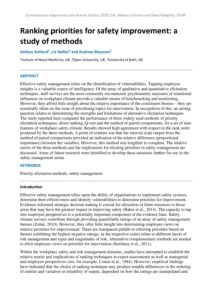| Document | Author Anthea Ashford, Liz Hellier and Andrew Weyman |
| Abstract Effective safety management relies on the identification of vulnerabilities. Tapping employee insights is a valuable source of intelligence. Of the array of qualitative and quantitative elicitation techniques, staff surveys are the most commonly encountered: psychometric measures of situational influences on workplace climate provide a valuable means of benchmarking and monitoring. However, they afford little insight about the relative importance of the constituent themes – they are essentially silent on the issue of prioritising topics for intervention. In recognition of this, an arising question relates to determining the strengths and limitations of alternative elicitation techniques. The study reported here compared the performance of three widely used methods of priority elicitation techniques: direct ranking, Q-sort and the method of paired comparisons, for a set of nine features of workplace safety climate. Results showed high agreement with respect to the rank order produced by the three methods. A point of contrast was that the interval scale output from the method of paired comparisons provided an indication of the relative difference (proportional importance) between the variables. However, this method was lengthier to complete. The relative merits of the three methods and the implications for eliciting priorities in safety management are discussed. Areas of future research were identified to develop these measures further for use in the safety management arena. |

